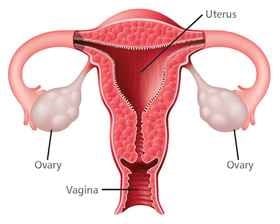If you have a symptom that suggests Ovarian Cancer, your doctor must find out whether it is due to cancer or to some other cause. Your doctor may ask about your personal and family medical history.
You may have one or more of the following tests:
Physical Exam
Your doctor checks general signs of health. Your doctor may press on your abdomen to check for tumours or an abnormal build-up of fluid. A sample of fluid can be taken to look for Ovarian Cancer cells.
Pelvic Exam
Your doctor feels the ovaries and nearby organs for lumps or other changes in their shape or size.
Blood Tests
Your doctor may order blood tests. The lab may check the level of several substances, including CA-125. CA-125 is a substance found on the surface of Ovarian Cancer cells and on some normal tissues. A high CA-125 level could be a sign of cancer or other conditions. The CA-125 test is not used alone to diagnose Ovarian Cancer. This test is approved by the Food and Drug Administration for monitoring a woman's response to Ovarian Cancer treatment and for detecting its return after treatment.
Ultrasound
The ultrasound device uses sound waves that people cannot hear. The device aims sound waves at organs inside the pelvis. The waves bounce off the organs. A computer creates a picture from the echoes. The picture may show an ovarian tumour. For a better view of the ovaries, the device may be inserted into the vagina (transvaginal ultrasound).
Biopsy
A biopsy is the removal of tissue or fluid to look for cancer cells. Based on the results of the blood tests and ultrasound, your doctor may suggest surgery (a laparotomy) to remove tissue and fluid from the pelvis and abdomen. Surgery is usually needed to diagnose Ovarian Cancer.
Laparoscopy
The doctor inserts a thin, lighted tube (a laparoscope) through a small incision in the abdomen. Laparoscopy may be used to remove a small, benign cyst or an early Ovarian Cancer. It may also be used to learn whether cancer has spread.


















